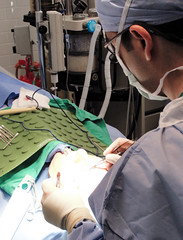 1) What are the common causes of ptosis (droopy eyelids)?
1) What are the common causes of ptosis (droopy eyelids)?The most common reason for ptosis is acquired ptosis , which develops as we age. This is due to disinsertion of the tendon that holds the eyelid up in a normal anatomic position. Another cause is congenital ptosis , which happens when a child is born with droopy eyelids. This is rather an urgent medical condition for the child and surgery may be needed to prevent permanent loss of vision in the affected eye. Other rare causes of ptosis include myogenic ptosis from conditions such as Myasthenia gravis, neurogenic ptosis , due to third nerve palsy and mechanical ptosis from tumors or trauma.
2) Why is it urgent to see a doctor when my child has droopy eyelids?In order for the visual system to develop normally, each eye needs to receive the visual information independently. In other words if the child has droopy eyelids, this will result in blockage of the visual information to the brain, thus leading to irreversible poor vision. Therefore it is important to surgically raise the eyelids to prevent permanent loss of vision
3) How is this procedure done on my child?All surgeries for ptosis are performed in an outpatient basis. This means the child will have nothing to eat after midnight before surgery and the surgery will be done in the morning with the child going home the same day. The surgery will vary depending on the type of ptosis which is determined by Dr. Parsa on the initial exam. In general most children with congenital ptosis will need a form of sling procedure. The sling is used to raise the eyelid to the correct level.
4) What are the post operative instructions for my child?The first 24 hours after surgery use ice packs or frozen peas over the eyelids as much as possible, this is to decrease the post operative swelling. Children's Tylenol should be sufficient to address any pain. You will be given an antibiotic ointment which should be applied to the incision site 3 times a day for one week. The first post operative visit will be a week after surgery. Post operative swelling for a few weeks is normal. The sutures used are absorbable and will not need to be removed.
5) When can my child go back to school?Typically the child will be able to go back to school after one week of rest.
6) I notice and I am told by others that I always look tired, is there anything that could be done for this?Droopy eyelids can give the false impression that you are tired. Raising the eyelid will give a more awake and alert, youthful appearance.
7) Does my insurance cover this procedure?The insurance should cover most children with ptosis because of its urgency. However on adults a visual field test is performed to determine how much of the superior vision is affected by the ptosis.
8) What type of anesthesia is used?In children the procedure is performed under general anesthesia. In adults most eyelid surgery can be performed under local anesthesia. If desired, local anesthesia with sedation can be performed. This type of anesthesia, also known as Monitored Anesthesia Care ( MAC ), is performed by an anesthesiologist. The main advantages of this anesthesia are: (1) it does not require putting a breathing tube in the throat, (2) it does not require a breathing machine, (3) the recovery is much faster, (4) there is less nausea after surgery. All of these elements translate into greater comfort and safety.
During MAC anesthesia, an intravenous needle is placed into one of the veins of the arm or hand. Relaxing medication is given to make the patient fall asleep. The amount of medication is adjusted as needed. After the patient is asleep, numbing medicine is placed in the skin of the area that is being operated on. During the procedure the patient is unaware of anything going on and cannot hear anything, yet he or she is breathing normally.
 Q: A friend mentioned getting Transconjunctival blepharoplasty. What does this mean? Is it better than traditional eyelift surgery? I'm 52 and would like to help my under eye bags.
Q: A friend mentioned getting Transconjunctival blepharoplasty. What does this mean? Is it better than traditional eyelift surgery? I'm 52 and would like to help my under eye bags.






